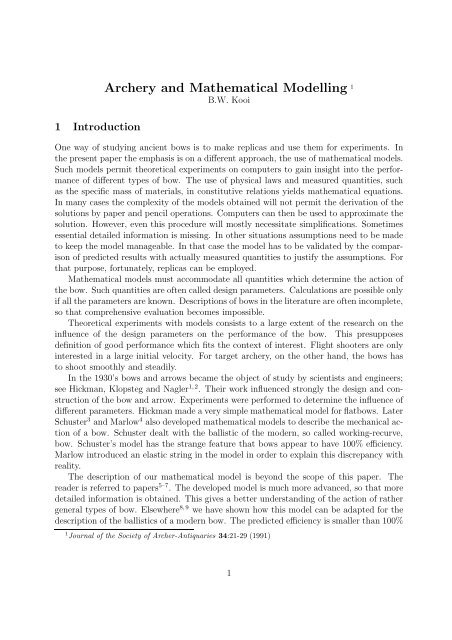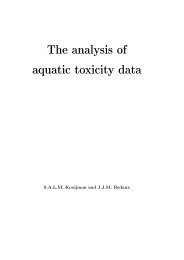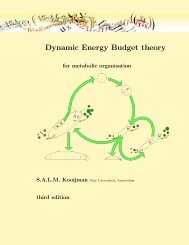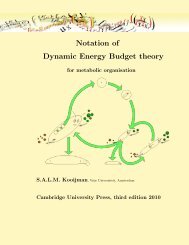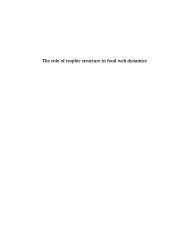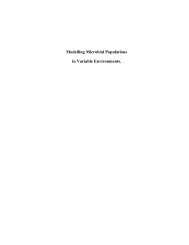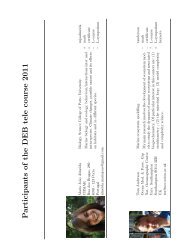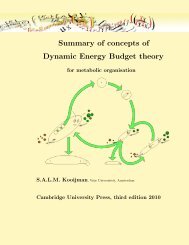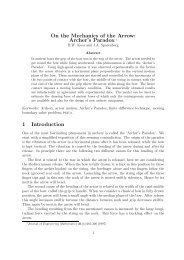Archery and Mathematical Modelling 1
Archery and Mathematical Modelling 1
Archery and Mathematical Modelling 1
Create successful ePaper yourself
Turn your PDF publications into a flip-book with our unique Google optimized e-Paper software.
1 Introduction<strong>Archery</strong> <strong>and</strong> <strong>Mathematical</strong> <strong>Modelling</strong> 1B.W. KooiOne way of studying ancient bows is to make replicas <strong>and</strong> use them for experiments. Inthe present paper the emphasis is on a different approach, the use of mathematical models.Such models permit theoretical experiments on computers to gain insight into the performanceof different types of bow. The use of physical laws <strong>and</strong> measured quantities, suchas the specific mass of materials, in constitutive relations yields mathematical equations.In many cases the complexity of the models obtained will not permit the derivation of thesolutions by paper <strong>and</strong> pencil operations. Computers can then be used to approximate thesolution. However, even this procedure will mostly necessitate simplifications. Sometimesessential detailed information is missing. In other situations assumptions need to be madeto keep the model manageable. In that case the model has to be validated by the comparisonof predicted results with actually measured quantities to justify the assumptions. Forthat purpose, fortunately, replicas can be employed.<strong>Mathematical</strong> models must accommodate all quantities which determine the action ofthe bow. Such quantities are often called design parameters. Calculations are possible onlyif all the parameters are known. Descriptions of bows in the literature are often incomplete,so that comprehensive evaluation becomes impossible.Theoretical experiments with models consists to a large extent of the research on theinfluence of the design parameters on the performance of the bow. This presupposesdefinition of good performance which fits the context of interest. Flight shooters are onlyinterested in a large initial velocity. For target archery, on the other h<strong>and</strong>, the bows hasto shoot smoothly <strong>and</strong> steadily.In the 1930’s bows <strong>and</strong> arrows became the object of study by scientists <strong>and</strong> engineers;see Hickman, Klopsteg <strong>and</strong> Nagler 1, 2 . Their work influenced strongly the design <strong>and</strong> constructionof the bow <strong>and</strong> arrow. Experiments were performed to determine the influence ofdifferent parameters. Hickman made a very simple mathematical model for flatbows. LaterSchuster 3 <strong>and</strong> Marlow 4 also developed mathematical models to describe the mechanical actionof a bow. Schuster dealt with the ballistic of the modern, so called working-recurve,bow. Schuster’s model has the strange feature that bows appear to have 100% efficiency.Marlow introduced an elastic string in the model in order to explain this discrepancy withreality.The description of our mathematical model is beyond the scope of this paper. Thereader is referred to papers 5–7 . The developed model is much more advanced, so that moredetailed information is obtained. This gives a better underst<strong>and</strong>ing of the action of rathergeneral types of bow. Elsewhere 8, 9 we have shown how this model can be adapted for thedescription of the ballistics of a modern bow. The predicted efficiency is smaller than 100%1 Journal of the Society of Archer-Antiquaries 34:21-29 (1991)1
length. The archer on the other h<strong>and</strong> sets the fistmele by the adjustment of the length ofthe string.For flight shooting the initial velocity of the arrow leaving the string is very important.The larger this velocity the larger the maximum attainable distance. The actual distancedepends also on the elevation angle (nearly 45 ◦ ) <strong>and</strong> the drag of the arrow in the air. Arequirement for target shooting <strong>and</strong> hunting is that the bow shoots smoothly. It is difficultto translate this feature into mathematics. High efficiency is a good criterion. However, aheavy arrow always yields a high efficiency <strong>and</strong>, unfortunately so, a small initial velocity<strong>and</strong> therefore a short distance. Hence, we have a combination of factors. The recoil-force,i.e. the force, the archer feels in the bowh<strong>and</strong> after the release, also seems to be important.The way this force changes in time can be calculated with the model, but it cannot besummarized by a single number.The bow should not exaggerate human error. To assess the sensitivity of the bow, itsperformance is calculated repeatedly with slightly different values for the design parameters.If the performance depends strongly on a design parameter, the archer has to takecare that the value of this parameter is as constant as possible. To achieve this archersneed skill besides technique.3 Validation of the mathematical model<strong>Mathematical</strong> models may be beautiful by themselves <strong>and</strong> the way to solve them interesting,but they should mimic the mechanical action of the bow <strong>and</strong> arrow good enough ifthey are used in the design of a bow or a sensitivity study.We checked static action by comparing the measured weight of a replica of longbowsfound on the recovered Mary Rose with calculated values. The Mary Rose was HenryVIII ’s warship which sank in 1545 in The Solent, a mile outside Portsmouth. She wasrecovered in 1982 with 139 yew longbows. Tests with these bows have demonstratedthat while it is possible to string <strong>and</strong> draw the bows to 30 inch, considerable degradationwithin the cell structure of the wood has prevented a realistic assessment of the originalweight. A replica was made by Roy King, bowyer to the Mary Rose Trust. Prof. P.Pratt, Imperial College of Science & Technology London, measured all parameters whichare required to calculate the mechanical performance of a bow. The weight of this replicawas also measured. It compared very well with the predicted value calculated with themathematical model (differences within 1%) 11 . These results imply that if a good estimateof the original modulus <strong>and</strong> density can be obtained, the original mechanical performanceof the longbows can be calculated from the dimensions of these recovered bows.Data obtained with the test set-up described extensively elsewhere 10 , permitted a comparisonof predicted <strong>and</strong> measured arrow velocities. The dynamic action of bows could bechecked in this way. We used a modern bow made of maple in the core <strong>and</strong> glass fibresembedded in strong synthetic resin at both sides of the core. All the essential parameterslisted above were measured. We measured the density <strong>and</strong> elastic modulus of both thewood <strong>and</strong> the fibreglass <strong>and</strong> at a number of stations along the limbs the shape of the cross-3
a) b)Figure 1: Non-recurve bows: Static deformation shapes (a) of the KL-bow <strong>and</strong> (b) of the ANbow.sections. The results were used to determine the bending properties of the limbs. Finallythe elastic modulus <strong>and</strong> the mass of the string were measured.The predicted weight was too high <strong>and</strong> therefore a knockdown factor was used for thebending stiffness of the limbs, so that the calculated weight became equal to the measuredvalue. The predicted amount of energy stored in the bow by drawing it from the bracedsituation to full draw, differed only slightly from the measured value. The measuredefficiency was a few percent below the calculated value. In the model internal <strong>and</strong> externaldamping are neglected. This explains part of the discrepancy.4 Classification of the bowThe classification of the bows we use is based on the geometrical shape <strong>and</strong> the elasticproperties of the limbs. The bows of which the upper half is depicted in Figure 1 are callednon-recurve bows. In the model the bow is assumed to be symmetric with respect to theline of aim. So we need to deal with only one half of the bow. These bows have contactwith the string only at their tips. In the case of the static-recurve bow, see Figure 2, theoutermost parts of the recurved limbs (the ears) are stiff. In the braced situation the stringrests on string-bridges. These string-bridges are fitted to prevent the string from slippingpast the limbs. When such a bow is drawn, at some moment the string leaves the bridges<strong>and</strong> has contact with the limbs only at the tips. In a working-recurve bow the limbs arealso curved in the ’opposite’ direction in the unstrung situation, see Figure 3. The partsof a working-recurve bow near the tips, however, are elastic <strong>and</strong> bend during the finalpart of the draw. When one draws such a bow, the length of contact between string <strong>and</strong>limb decreases gradually until the point where the string leaves the limb coincides with the4
a) b)Figure 2: Static-recurve bows: Static deformation shapes (a) of the PE-bow <strong>and</strong> (b) of theTU-bow.a) b)Figure 3: Working-recurve bows: Static deformation shapes (a) of the ER-bow <strong>and</strong> (b) of theWR-bow.5
Table 1: Quality coefficients for various bows. Note that the values for the working recurveWR-bow are adapted for the masses of the arrow <strong>and</strong> string but the stiffness of its stringis about twice those of the other bows.Bow q η νKL-bow 0.407 0.765 2.01AN-bow 0.395 0.716 1.92PE-bow 0.432 0.668 1.94TU-bow 0.491 0.619 1.99ER-bow 0.810 0.417 2.08WR-bow 0.434 0.770 2.09tip. The string remains in that position during the final part of the draw. Elsewhere 5 wedealt with the statics (before arrow release) of these three types of bow. We studied thedynamics (after arrow release) of the non-recurve bow 6 , the dynamics of the static-recurvebow 7 <strong>and</strong> finally that of the working-recurve bow 8 .In the model the action of a bow <strong>and</strong> arrow combination is fixed by one point in ahigh dimensional parameter space. Representations of different types of bow used in thepast <strong>and</strong> in our time form clusters in this parameter space. We study the performance ofdifferent types of bow <strong>and</strong> start with a straight-end bow described by Klopsteg 1 . This bowis referred to as the KL-bow. The shape of the KL-bow for various draw lengths is shownin Figure 1(a). The AN-bow represents another non-recurve bow, the Angular bow foundin Egypt <strong>and</strong> Assyria. The shape of the unstrung bow, shown in Figure 1(b), implies thatin the braced situation the limbs <strong>and</strong> the string form the characteristic triangular shape.We consider two static-recurve bows, one from China, India <strong>and</strong> Persia, to be called thePE-bow, <strong>and</strong> one which resembles a Turkish flight bow, to be called the TU-bow. Theshapes of these bows for various draw-lengths are shown in Figure 2. One of the workingrecurvebows, to be called the ER-bow, possesses an excessive recurve. It resembles a bowdescribed <strong>and</strong> shot by Hickman 1 . The other working-recurve bow is the modern one whichwas used for the validation of the model 10 . This bow shown in Figure 3(b), is referred toas the WR-bow.Three quality coefficients for these types of bow are shown in Table 1. These coefficientsare defined for equal weight, draw length <strong>and</strong> mass of the limbs. Moreover the mass of thearrows <strong>and</strong> strings were the same for all reported bows. This makes an honest comparisonpossible. Unfortunately the stiffness of the string of the WR-bow is about twice that ofthe other bows. The static quality coefficient q measures how much recoverable energy isstored in the fully drawn bow. It is defined as the additional deformation energy stored6
Figure 4: Static (F ) <strong>and</strong> dynamic (E) forcedrawcurves for the static-recurve PE-bow.in the elastic limbs <strong>and</strong> string by drawing the bow from the braced into the fully drawnposition divided by the weight timed the draw length. The efficiency η is the kinetic energytransferred to the arrow divided by the just mentioned additional deformation energy. So,it is the part of the available amount of energy which is transferred to the arrow as usefulenergy. The third quality coefficient ν is proportional to the initial velocity. The constantdepends only on the weight, draw length <strong>and</strong> mass of the limbs.The static quality coefficient is 1 when the draw-force is uniformly equal to the weightfor all draw lengths for a fictitious bow with no fistmele. Just as the efficiency, thiscoefficient gives the actual value relative to a basic, characteristic value. The results showthat in practice q is slightly smaller that 0.5 except for the ER-bow with the extremerecurve.In what follows we will comment on a statement made by Hamilton 12 :”The function of the ”ears”, or siyahs, is well known today <strong>and</strong> no one canquestion the superiority of the type of bow which still holds the world recordof shooting an arrow 972 yards (Klopsteg 2 )”.Hamilton continues:”The siyah contributes in three ways to improve cast in the arrow”.”(1) It provides leverage for the bowstring so the bow can be designed toapproach maximum weight earlier in the draw allowing more energy to bestored for the cast”.This statement is in agreement with our results. The static quality coefficient of the PEbowis larger then of the straight-end KL-bow.In Figure 4 the static <strong>and</strong> dynamic force draw curve are shown for the PE-bow. Theline indicated with F shows a bend at the place where the string leaves the bridges. TheTU-bow stores even more energy in the fully drawn position, obviously because of therecurve of the working part of the limbs. So the good static performance of flight bowsmay result only partly from the use of the stiff ears.7
”(2) Upon release, the bowstring imparts its energy to the arrow more uniformly<strong>and</strong> at a higher <strong>and</strong> more sustained rate of thrust than in a ordinary bowwithout siyahs.”This statement is not supported by the results obtained with the model. Because ofthe relatively heavy ears, there is a sudden decrease in the force in the string <strong>and</strong>, byimplication, in the acceleration force upon the arrow. The result of this is oscillatorybehaviour as shown in Figure 4. Consequentially the efficiency of static-recurve bows arather low. The amplitude of the oscillations depends largely on the modulus of elasticityof the string <strong>and</strong> the mass of the arrow relative to the mass of the ears.”(3) When the bow string reaches the bridges it is in effect shortened, increasingthe tension again on the bowstring <strong>and</strong> giving the arrow a final snap as it leavesthe bow.”The dynamic force draw curve (E in Figure 4) shows that the acceleration of the arrow israther large when the string has contact with the bridges.Notwithst<strong>and</strong>ing this, the efficiency η of the PE-bow <strong>and</strong> certainly that of the TUbow,is rather low. This implies that the initial velocity ν is not as large as one wouldexpect on the basis of the static performance. This is caused by the relative heavy ears.These considerations demonstrate why these bows can, inherently, not be better than longstraight-end bows. A large part of the available energy remains in the vibrating limbs <strong>and</strong>string after arrow exit.This holds even to a larger extent for the ER-bow. The string cannot slow down thenow light ends of the limbs during the final part of the acceleration of the arrow when thebow is close to its braced situation again.The modern WR-bow seems to be a good compromise between the non-recurve bow<strong>and</strong> the static-recurve bow. The recurve yields a good static quality coefficient <strong>and</strong> thelight tips of the limbs give a reasonable efficiency.5 Construction of the bowBut what made the Turkish flight bow a superb type of bow for flight shooting? Until nowwe dealt with the mechanics of the bow but not with its construction. The efficiency isgreatly affected by the relative mass of the arrow relative to that of the limbs. For a fixedmass of the arrow, the lighter the limbs the better the efficiency. This is the item wheretechnology becomes important. The minimum mass of the limbs for a fixed weight <strong>and</strong>draw is determined largely by the appropriateness of the material to store energy.In the past man used bows which differ not only in shape but also in the materialsapplied. Simple bows made out of one piece of wood, straight <strong>and</strong> tapering towards theends have been used by primitives in Africa, South America <strong>and</strong> Melanesia. In the famousEnglish longbow the different properties of sapwood <strong>and</strong> heartwood were deliberately putto use. Eskimoes used wood together with cords plaited of animal sinews <strong>and</strong> lashed to thewooden core at various points. The Angular bow found in Egypt <strong>and</strong> Assyria are examples8
Table 3: Parameters for a number of bows <strong>and</strong> an estimation of d bv the weight times drawlength divided by the mass of one limb. For comparison also the estimated values for δ bvare given. When materials are used to their full extend, d bv divided by about 4 equals δ bv .Ref. Type weight draw mass length δ bv d bvkgf cm kg cm kgf cm/kg kgf cm/kg1flatbow 15.5 71.12 0.325 182.9 9000 680011longbow 46.5 74.6 0.794 187.4 9000 870016steelbow 17.2 71.12 0.709 168.9 1300 350017Tartar 46.0 73.66 1.47 188.0 20000 460018Turkish 69.0 71.12 0.35 114.0 20000 2800010modern 12.6 71.12 0.29 170.3 30000 6200by a difference in this mechanical property. We decided to use a value of 0.75 10 5 kgf/cm 2 .Parenthetically, the spread in the modulus of elasticity of yew yields makes the predictionsof the weight (almost proportional to the modulus of elasticity of yew ) of the Mary Rosebows uncertain.The quantity denoted by d bv is proportional to the amount of energy stored in the bowper unit of mass. It equals the weight times draw length divided by the mass of one limb.When materials are used to their full extend d bv divided by about 4 should equal δ bv .We saw that because of the stiff ears or a recurve of the working parts of the limbs,much energy is stored in the static-recurve bow. In a recurved bow the amount of energy inthe braced position is already large. This implies that the limbs must be relative heavy inorder to store this extra <strong>and</strong> not usable energy, in addition to the recoverable energy. Thisis the price paid for a larger static quality coefficient. On the other h<strong>and</strong>, sinew <strong>and</strong> hornare relative tough <strong>and</strong> flexible materials, see Table 2. This explains why the use of thesematerials fits well with the recurved shape of the unstrung bow. The values in Table 3show that the Turkish bow is very strong but also light. This indicates why it permits oneto shoot a light arrow a long distance. A short bow is moreover easier in operation <strong>and</strong> issuited for the use on horse back. In a letter 19 to the author E. McEwen informs that: ”Popedid not properly test his larger ‘Tartar’ (actually Manchu-Chinese) bow. He only drew it36 inches <strong>and</strong> bows of this type <strong>and</strong> size are made to draw as much as 40 inches”. Popeonly mentions the weight for a draw length of 29 inches. If the weight of this bow with adraw length of 101.6 cm is 70 kgf, we have d bv = 9700 kgf cm/kg. This value is still ratherlow <strong>and</strong> this means that the materials of this bow are used only partly. This supportsMcEwens 19 view that: ”this bow was probably a ‘test’ bow used for exercise <strong>and</strong> for themilitary examinations <strong>and</strong> not meant for actual shooting”. The values obtained for the10
straight-end bows look very realistic. In the modern bow there is a surplus of material nearthe riser section. This affects the efficiency only slightly. For, this part of the limb moveshardly <strong>and</strong> therefore the involved kinetic energy is small. In this bow there is also a ratherlarge amount of unrecoverable energy in the braced position. This puts a constraint on theamount of recurve. With respect to this, it is perhaps more important that the efficiencyof working-recurve bows decreases with increasing recurve.The mechanical properties ofthe materials of these bows, however, are much better than those of the ancient compositebows. Indeed, the modern bow holds now the longest flight shooting record.Additional features were added to improve the performance especially for target shooting;relative immunity of the mechanical properties to temperature <strong>and</strong> humidity variations,no tendency to follow the string, use of stabilizers, sculptured long centre-shot riser section,bow sights <strong>and</strong> last but not least stronger materials for bowstrings. Finally an improvedarrow design adds to the steadiness of the equipment.6 ConclusionsWe conclude that these results indicate that the initial velocity is about the same for alltypes of bow under similar conditions. So, within certain limits, the design parameterswhich determine the mechanical action of a bow arrow combination appear to be lessimportant than is often claimed. We would endorse a view one could call holistic. It is notalways possible to isolate a single feature <strong>and</strong> state that it solely accounts for a good or badperformance of the whole bow, as Hamilton 12 did. Rausing 20 studies the development of thecomposite bow. According to him, the fact the static quality coefficient of the short staticrecurvebow to be larger than that of the short straight bow, disposes of the statement ofPitt-Rivers, Balfour <strong>and</strong> Clark: ”the composite bow has no inherent superiority over thewooden self-bow, so long as the latter was made from the most favourable kinds of timber<strong>and</strong> expertly used”. The results obtained with the mathematical model suggest that, if theword inherent has the meaning within the context we used it in Section 4, their statementis true. A combination of many technical factors made the composite flight bow better forflight shooting.The quality coefficients of the modern bow are only slightly better than those of theother types of bow. Materials used in modern working-recurve bows can store more deformationenergy per unit of mass than the materials used in the past. Moreover the mechanicalproperties of these materials are more durable <strong>and</strong> much less sensitive to changingweather conditions. This contributes most to the improvement of the modern bow.We hope that we have shown that mathematical modelling can be a helpful tool in theresearch on archery, not only for the design of new bow equipment but also for underst<strong>and</strong>ingthe development of the bow in the past.11
References1 C. N. Hickman, F. Nagler, <strong>and</strong> P. E. Klopsteg. <strong>Archery</strong>: the technical side. National Field<strong>Archery</strong> Association, Redl<strong>and</strong>s (Ca), 1947.2 P.E. Klopsteg. Turkish archery <strong>and</strong> the composite bow. Simon <strong>Archery</strong> Foundation, Manchester,1987.3 B. G. Schuster. Ballistics of the modern-working recurve bow <strong>and</strong> arrow. Am. J. Phys.,37:364–373, 1969.4 W. C. Marlow. Bow <strong>and</strong> arrow dynamics. Am. J. Phys., 49:320–333, 1981.5 B. W. Kooi. On the Mechanics of the Bow <strong>and</strong> Arrow. PhD thesis, Rijksuniversiteit Groningen,1983.6 B. W. Kooi <strong>and</strong> J. A. Sparenberg. On the static deformation of a bow. Journal of EngineeringMathematics, 14:27–45, 1980.7 B. W. Kooi. On the mechanics of the bow <strong>and</strong> arrow. Journal of Engineering Mathematics,15:119–145, 1981.8 B. W. Kooi. The ’cut <strong>and</strong> try’ method in the design of the bow. In H. A. Eschenauer,C. Mattheck, <strong>and</strong> N. Olhoff, editors, Engineering Optimization in Design Processes, volume 63of Lecture Notes in Engineering, pages 283–292, Berlin, 1991. Springer-Verlag.9 B. W. Kooi. On the mechanics of the modern working-recurve bow. Computational Mechanics,8:291–304, 1991.10 C. Tuijn <strong>and</strong> B. W. Kooi. The measurement of arrow velocities in the students’ laboratory.European Journal of Physics, 13:127–134, 1992.11 R. Hardy. Longbow. Mary Rose Trust, Portsmouth, 1986. pp. 4-6.12 T. M. Hamilton. Native American Bows. Missouri Archaeological Society, Columbia (Ms),1982.13 J. E. Gordon. Structures or Why Things Don’t Fall Down. Pelican, Harmondsworth, 1978.14 W. F. Paterson. ”Mary Rose” - a preliminary report. Journal of the Society of Archer-Antiquaries, 23:29–34, 1980.15 W. F. Paterson. ”Mary Rose” - a second report. Journal of the Society of Archer-Antiquaries,24:4–6, 1981.16 R. P. Elmer. Target <strong>Archery</strong>. Hutchinson’s Library of sports <strong>and</strong> pastimes, London, 1952.17 S. T. Pope. Bows <strong>and</strong> Arrows. University of California Press, Berkeley (CA), 1974.18 Sir R. Payne-Gallwey. The Crossbow. Holl<strong>and</strong> Press, London, 1976.19 E. McEwen. Private communications, 1991.12
20 G. Rausing. The Bow. Acta Archaeologica Lundensia. CWK Gleerups Förlag, Lund, Sweden,1967.13


